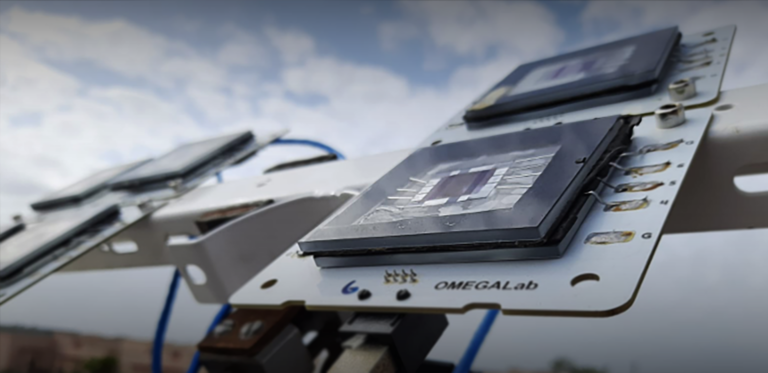Material Science and Engineering
The raw power of human motion
Standalone power modules that harvest and convert vibrations from their surroundings into electricity could soon fuel future microsystems.

Autonomy is a much-anticipated feature of next-generation microsystems, such as remote sensors, wearable electronic gadgets, implantable biosensors and nanorobots. KAUST researchers led by Husam Alshareef, Jr-Hau He and Khaled Salama have developed small standalone devices by integrating maintenance-free power units that produce and use their own fuel instead of relying on an external power source¹,².
Triboelectric nanogenerators (TENGs) capture mechanical energy from their surroundings, such as vibrations and random motion produced by humans, and convert it into electricity. In these tiny generators, frictional contact between materials of different polarity creates oppositely charged surfaces. Repeated friction causes electrons to hop between these surfaces, resulting in electric voltage.

The lead-halide-based material features optoelectronic properties that are desirable in solar cells and light-emitting diodes.
© 2018 KAUST
“We exploited this triboelectric effect to harvest energy from simple movements, such as hand clapping, finger tapping and routine hand motion, to drive different types of sensors,” says Alshareef.
The researchers have developed a self-powered photodetector by coupling the silicone-based polymer polydimethylsiloxane (PDMS) as a TENG with a material called an organometallic halide perovskite¹. The lead-halide-based material features optoelectronic properties that are desirable in solar cells and light-emitting diodes.
To streamline their design and eliminate the need for a motion actuator, He’s team fabricated the photodetector using two multilayered polymer-based sheets separated by a small gap. One sheet comprised the perovskite ultrathin film while the other contained a PDMS layer. The gap allowed the team to harness the triboelectric effect when the device was activated by finger tapping.
“The self-powered device showed excellent responsiveness to incident light, especially when exposed to light of low intensity,” says Mark Leung, the lead author of the photodetector study. Because of its flexible and transparent polymer components, it also retained its performance after being bent 1,000 times and regardless of the orientation of the incident light.
Pushing the boundaries further, the researchers engineered a wearable self-powered bracelet that can store the converted mechanical energy by combining a carbon-fiber-embedded silicone nanogenerator with MXene microsupercapacitors².
They incorporated nanogenerator and miniaturized electrochemical capacitors into a single monolithic device encased in silicone rubber. The leak-proof and stretchable shell provided a flexible and soft bracelet that fully conformed to the body. Fluctuations in the skin–silicone separation altered the charge balance between electrodes, causing the electrons to flow back and forth across the TENG and the microsupercapacitor to charge up.
In addition to exhibiting longer cycle life and short charging time, MXene microsupercapacitors can accumulate more energy in a given area than thin-film and micro-batteries, offering faster and more effective small-scale energy storage units for TENG-generated electricity. When active, the bracelet can use the stored energy to operate various electronic devices, such as watches and thermometers.
“Our ultimate goal is to develop a self-powered sensor platform for personalized health monitoring,” says Ph.D. student Qiu Jiang, the lead author of the self-charging band project. The team is now planning to introduce sensors into the system to detect biomarkers in human sweat.
References
- Leung, S.-F., Ho, K.-T., Kung, P.-K., Hsiao, V.K. ., Alshareef, H.N. Wang, Z.L. & He, J-H. A self-powered and flexible organometallic halide perovskite photodetector with very high detectivity. Advanced Materials 30, 1704611 (2018).| article
-
Jiang, Q., Wu, C., Wang, Z., Wang, A. C., He, J.-H. Wang, Z.L. & Alshareef, H.N. MXene electrochemical microsupercapacitor integrated with triboelectric nanogenerator as a wearable self-charging power unit. Nano Energy 45, 266–272 (2018).| article
You might also like

Material Science and Engineering
Electron movie guides design of layered perovskite materials

Material Science and Engineering
Remote region sensor for essential vitamin deficiency

Material Science and Engineering
Low-power hydrogen sensor detects leaks in an instant

Material Science and Engineering
Illuminating pathways to long-lived organic solar cells

Chemistry
Beating the dark current for safer X-ray imaging

Chemical Engineering
Net benefits for advanced materials design

Material Science and Engineering
Atom-thin insulator grown into perfect films

Material Science and Engineering




